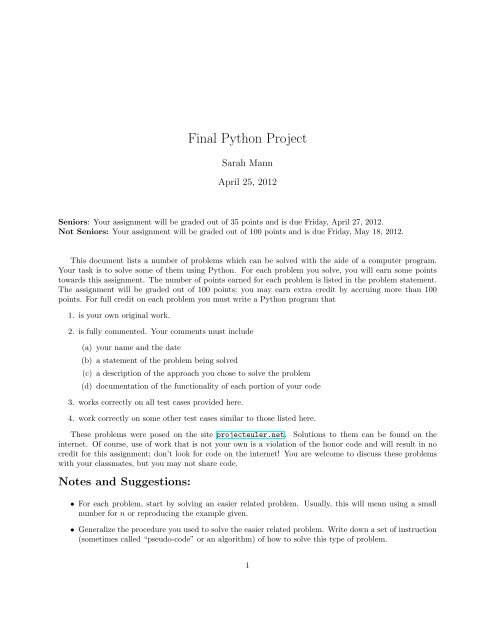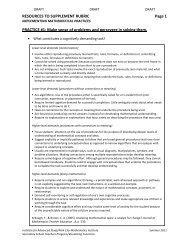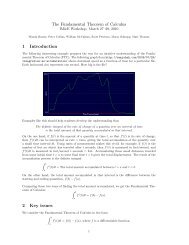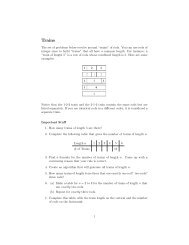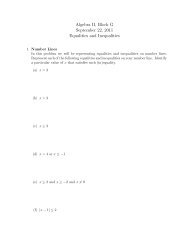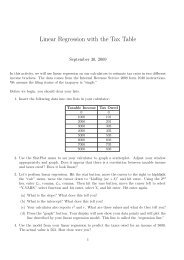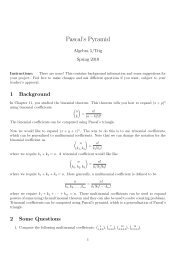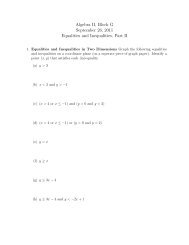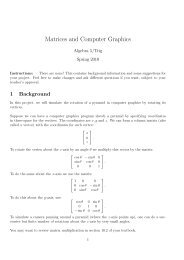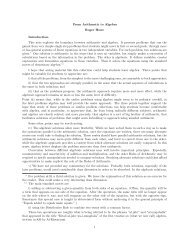Create successful ePaper yourself
Turn your PDF publications into a flip-book with our unique Google optimized e-Paper software.
<strong>Final</strong> <strong>Python</strong> <strong>Project</strong><br />
Sarah Mann<br />
April 25, 2012<br />
Seniors: Your assignment will be graded out of 35 points and is due Friday, April 27, 2012.<br />
Not Seniors: Your assignment will be graded out of 100 points and is due Friday, May 18, 2012.<br />
This document lists a number of problems which can be solved with the aide of a computer program.<br />
Your task is to solve some of them using <strong>Python</strong>. For each problem you solve, you will earn some points<br />
towards this assignment. The number of points earned for each problem is listed in the problem statement.<br />
The assignment will be graded out of 100 points; you may earn extra credit by accruing more than 100<br />
points. For full credit on each problem you must write a <strong>Python</strong> program that<br />
1. is your own original work.<br />
2. is fully commented. Your comments must include<br />
(a) your name and the date<br />
(b) a statement of the problem being solved<br />
(c) a description of the approach you chose to solve the problem<br />
(d) documentation of the functionality of each portion of your code<br />
3. works correctly on all test cases provided here.<br />
4. work correctly on some other test cases similar to those listed here.<br />
These problems were posed on the site projecteuler.net. Solutions to them can be found on the<br />
internet. Of course, use of work that is not your own is a violation of the honor code and will result in no<br />
credit for this assignment; don’t look for code on the internet! You are welcome to discuss these problems<br />
with your classmates, but you may not share code.<br />
Notes and Suggestions:<br />
• For each problem, start by solving an easier related problem. Usually, this will mean using a small<br />
number for n or reproducing the example given.<br />
• Generalize the procedure you used to solve the easier related problem. Write down a set of instruction<br />
(sometimes called “pseudo-code” or an algorithm) of how to solve this type of problem.<br />
1
• Present your procedure to another classmate, Mr. Herzog, or Sarah. Can this third party follow your<br />
instructions to solve this problem correctly?<br />
• Translate your procedure into <strong>Python</strong> code.<br />
• Sometimes you may need to do things in <strong>Python</strong> that we have not yet specifically discussed. This is<br />
the nature of programming; you never know all the capabilities of a programming language and have<br />
to learn new tricks as the need arise. At the end of this document I have include a few new functions<br />
in <strong>Python</strong> that I think you might need. Mr. Herzog and Sarah can suggest other <strong>Python</strong> functions as<br />
needed.<br />
Problem 1 (30 points)<br />
If we list all the natural numbers below 10 that are multiples of 3 or 5, we get 3, 5, 6 and 9. The sum of<br />
these multiples is 23. Write a program that asks the user for a value of n then computes the sum of all the<br />
multiples of 3 or 5 below n. Here are three examples:<br />
• The sum of all the multiples of 3 or 5 below 10 is 23.<br />
• The sum of all the multiples of 3 or 5 below 100 is 2318.<br />
• The sum of all the multiples of 3 or 5 below 1500 is 524250.<br />
Problem 2 (30 points)<br />
Each new term in the Fibonacci sequence is generated by adding the previous two terms. By starting with<br />
1 and 2, the first 10 terms will be<br />
1, 2, 3, 5, 8, 13, 21, 34, 55, 89, . . .<br />
The sum of the even-valued terms in the Fibonacci sequence whose value does not exceed 50 is 44. Write a<br />
program that asks the user for a value of n, then computes the sum of the even-valued terms in the Fibonacci<br />
sequence whose value does not exceed n. Here are three examples:<br />
• The sum of the even-valued terms in the Fibonacci sequence whose value does not exceed 50 is 44.<br />
• The sum of the even-valued terms in the Fibonacci sequence whose value does not exceed 150 is 188.<br />
• The sum of the even-valued terms in the Fibonacci sequence whose value does not exceed 15 million is<br />
19,544,084.<br />
2
Problem 3 (30 points)<br />
The prime factors of 13,195 are 5, 7, 13, and 29. The largest of these is 29. Write a program that asks the<br />
user for a value of n, then computes the largest prime factor of n. Here are three examples:<br />
• The largest prime factor of 13,195 is 29.<br />
• The largest prime factor of 4,749,886 is 523.<br />
• The largest prime factor of 59,331,030 is 7817.<br />
• The largest prime factor of 155,131,173,990 is 2,381. (Note: if your program throws an error on this<br />
example, don’t worry about it. It will not count against you.)<br />
Problem 4 (30 points)<br />
The sum of the squares of the first ten natural numbers is,<br />
1 2 + 2 2 + ... + 10 2 = 385<br />
The square of the sum of the first ten natural numbers is,<br />
(1 + 2 + ... + 10) 2 = 55 2 = 3025<br />
Hence the difference between the sum of the squares of the first ten natural numbers and the square of the<br />
sum is 3025 - 385 = 2640. Write a program that asks the user for a value of n, then computes the difference<br />
between the sum of the squares of the first n natural numbers and the square of the sum. Here are three<br />
examples:<br />
• The difference between the sum of the squares of the first 10 natural numbers and the square of the<br />
sum is 2640.<br />
• The difference between the sum of the squares of the first 50 natural numbers and the square of the<br />
sum is 1,582,700.<br />
• The difference between the sum of the squares of the first 120 natural numbers and the square of the<br />
sum is 52,124,380.<br />
Problem 5 (35 points)<br />
By listing the first six prime numbers: 2, 3, 5, 7, 11, and 13, we can see that the 6th prime is 13. Write a<br />
program that asks the user for a value of n, then computes the nth prime number. Here are three examples:<br />
• The 6th prime number is 13.<br />
• The 100th prime number is 541.<br />
• The 12,000th prime number is 128,189.<br />
3
Problem 6 (40 points)<br />
The sequence of triangle numbers is generated by adding the natural numbers. So the 7th triangle number<br />
would be 1 + 2 + 3 + 4 + 5 + 6 + 7 = 28. The first ten triangle numbers would be:<br />
1, 3, 6, 10, 15, 21, 28, 36, 45, 55, ...<br />
Let us list the factors of the first seven triangle numbers:<br />
triangle number factors<br />
1 1<br />
3 1,3<br />
6 1,2,3,6<br />
10 1,2,5,10<br />
15 1,3,5,15<br />
21 1,3,7,21<br />
28 1,2,4,7,14,28<br />
We can see that 28 is the first triangle number to have over five divisors. Write a program that asks the user<br />
for a value of n, then computes the first triangle number to have over n divisors. Here are three examples:<br />
• The first triangle number to have over 5 divisors is 28.<br />
• The first triangle number to have over 10 divisors is 120.<br />
• The first triangle number to have over 300 divisors is 2,162,160.<br />
Problem 7 (45 points)<br />
The following iterative sequence is defined for the set of positive integers:<br />
<br />
n<br />
n → 2 , n even<br />
3n + 1, n odd<br />
Using the rule above and starting with 13, we generate the following sequence:<br />
13, 40, 20, 10, 5, 16, 8, 4, 2, 1<br />
It can be seen that this sequence (starting at 13 and finishing at 1) contains 10 terms. Although it has not<br />
been proved yet (Collatz Problem), it is thought that all starting numbers finish at 1.<br />
Write a program that asks the user for a value of n, then find the starting number less than n that<br />
produces the longest chain. NOTE: Once the chain starts the terms are allowed to go above n. Here are<br />
three examples:<br />
• The longest sequence starting with a number less that 10 starts with 9 and has length 13.<br />
• The longest sequence starting with a number less that 1,000 starts with 871 and has length 113.<br />
• The longest sequence starting with a number less that 2 million starts with 1,723,519 and has length<br />
349.<br />
4
Problem 8 (45 points)<br />
Starting in the top left corner of a 2 × 2 grid, there are 6 routes (without backtracking) to the bottom right<br />
corner.<br />
Write a program that asks the user for a value of n, then finds the number of routes from the top left corner<br />
to the bottom right corner of and n × n grid without backtraking.<br />
• There are 6 routes from the top left corner to the bottom right corner of a 2 × 2 grid.<br />
• There are 184,756 routes from the top left corner to the bottom right corner of a 10 × 10 grid.<br />
• There are 126,410,606,437,752 routes from the top left corner to the bottom right corner of a 25 × 25<br />
grid.<br />
Appendix: Useful Functions<br />
This is a list of a few functions in <strong>Python</strong> you might find useful.<br />
1. The remainder operator : n % m computes the remainder of n divided by m. If you type 8 % 3 into<br />
your IDLE, it will return 3 because the remainder of 8 divided by 3 is 2. You can test if an number n<br />
is even by checking if n % 2 is zero. For example, 6 % 2 = 0 (since 6 is even), and 7 % 2 = 1 (since 7 is<br />
odd). How could you test if an number n is divisible by 3 using the % operator?<br />
2. The sum function: sum(LIST) returns the sum of all of the items in LIST. For example, sum([4,5,9])<br />
returns 18. sum(range(10)) returns 1 + 2 + 3 + 4 + 5 + 6 + 7 + 8 + 9 = 45. Try these in your IDLE.<br />
3. floor and ceiling: In the math library, the function math.floor(x) rounds x down to the nearest<br />
integer. For example, math.floor(3.5) returns 3.0. The function math.ceil(x) rounds x up to the<br />
nearest integer. For example, math.ceil(3.5) returns 4.0.<br />
5


